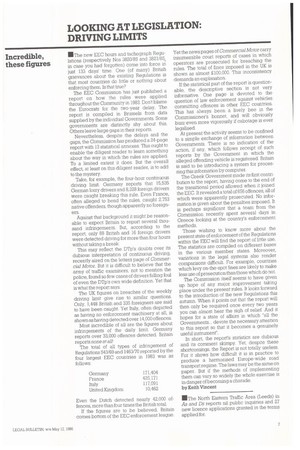LOOKING AT LEGISLATION: DRIVING LIMITS
Page 37

If you've noticed an error in this article please click here to report it so we can fix it.
Incredible, these figures
IIIThe new EEC hours and tachograph Regulations (respectively Nos 3820/85 and 3821/85, in case you had forgotten) come into force in just 133 days time. One (of many) British grievances about the existing Regulations is that most countries do little or nothing about enforcing them. Is that true?
The EEC Commission has just published a report on how the rules were applied throughout the Community in 1983. Don't blame the Eurocrats for the two-year delay. The report is compiled in Brussels from data supplied by the individual Governments Some governments are distinctly shy about this. Others leave large gaps in their reports.
Nevertheless, despite the delays and the gaps, the Commission has produced a 24-page report with 13 statistical annexes. This ought to enable the diligent reader to learn something about the way in which the rules are applied. To a limited extent it does. But the overall effect, at least on this diligent reader, is to add to the mystery.
Take, for example, the four-hour continuous driving limit. Germany reports that 15,535 German lorry drivers and 8,328 foreign drivers were caught breaking this rule. Even France, often alleged to bend the rules, caught 2,753 native offenders, though apparently no foreigners.
Against that background it might be reasonable to expect Britain to report several thousand infringements. But, according to the report, only 88 British and 16 foreign drivers were detected driving for more than four hours without taking a break.
This may reflect the DTp's doubts over its dubious interpretation of continuous driving, recently aired on the letters page of Commercial Motor. But it is difficult to believe that the army of traffic examiners, not to mention the police, found so few cases of drivers falling foul of even the DTp's own wide definition. Yet that is what the report says.
The UK figures on breaches of the weekly driving limit give rise to similar questions. Only, 1,448 British and 335 foreigners are said to have been caught. Yet Italy, often depicted as having no enforcement machinery at all, is shown as having detected over 14,000 offences.
Most incredible of all are the figures about infringements of the daily limit. Germany reports over 33,000 offences detected. Britain reports none at all!
The total of all types of infringement of Regulations 543/69 and 1463/70 reported by the four largest EEC countries in 1983 was as follows: Germany 171,404 France 425,171 Italy 117,091 United Kingdom 10,462 Even the Dutch detected nearly 42,000 offences, more than four times the British total.
If the figures are to be believed, Britain comes bottom of the EEC enforcement league.
Yet the news pages of Commercial Motor carry innumerable court reports of cases in which operators are prosecuted for breaching the rules. The total of fines imposed in the UK is shown as almost £100,000. This inconsistency demands an explanation.
lithe statistical part of the report is questionable, the descriptive section is not very informative. One page is devoted to the question of law enforcement against vehicles committing offences in other EEC countries. This has always been a lively bee in the Commissioner's bonnet, and will obviously buzz even more vigorously if cabotage is ever legalised.
At present the activity seems to be confined to a simple exchange of information between Governments. There is no indication of the action, if any, which follows receipt of such reports by the Government in which the alleged offending vehicle is registered. Britain is said to be introducing a system for processing this information by computer.
The Greek Government made its first contribution to the report, having come to the end of the transitional period allowed when it joined the EEC. It revealed a total of 656 offences, all of which were apparently prosecuted No information is given about the penalties imposed. It is perhaps significant that a team from the Commission recently spent several days in Greece looking at the country's enforcement methods.
Those wishing to know more about the present state of enforcement of the Regulations within the EEC will find the report of little use. The statistics are compiled on different bases in the various member states. Moreover, variations in the legal systems also render comparisons difficult, For example, countries which levy on-the-spot fines are likely to make less use of prosecution than those which do not.
The Commission itself seems to have given up hope of any major improvement taking place under the present rules. It looks forward to the introduction of the new Regulations this autumn. When it points out that the report will then only be required once every two years you can almost hear the sigh of relief. And it hopes for a state of affairs in which 'all the Governments.., devote the necessary attention to this report so that it becomes a genuinely useful instrument".
In short, the report's statistics are dubious and its comment skimpy. Yet, despite these shortcomings, the Report is not totally useless. For it shows how difficult it is in practice to produce a harmonised Europe-wide road transport regime. The laws may be the some on paper. But if the methods of implementing them can vary so widely the whole exercise is in danger of becoming a charade.
by Keith Vincent 111The North Eastern Traffic Area (Leeds) in As and Ds reports nil public inquiries and 27 new licence applications granted in the terms applied for.






















































































